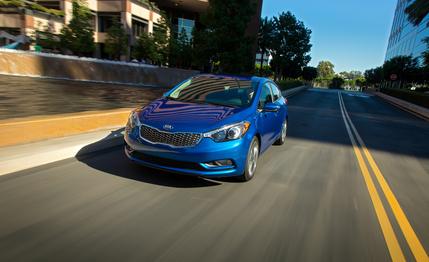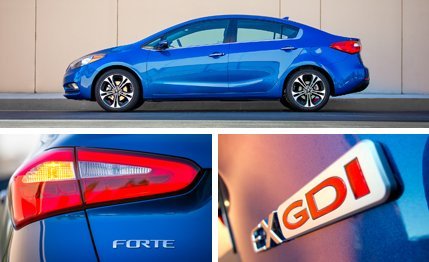
 First Drive Review
First Drive Review
“Forte” is how you say “Elantra” if you work for Hyundai’s Kia division, and viewed from that perspective, you have to wonder what’s the problem? The value-packed Elantra racked up more than 200,000 sales last year, even if it isn’t our favorite fork in the compact-car drawer. The outgoing Forte counted only a little more than a third of that total over the same period.
Kia decided it was time to reboot, and that’s what the 2014 Forte represents, a comprehensive makeover that allows the marketing troops to employ that most beloved of automotive descriptions—all-new—with what seems to be considerable justification.
Longer, Lower, Wider
The 2014 Forte four-door sedan is arrayed on a bigger canvas. At 106.3 inches, the new Forte’s wheelbase is stretched by 2.0 inches over that of the previous sedan. Additionally, overall length has been extended to 179.5, a gain of 1.2 inches, width expands 0.2 inch to 70.1, and height has been reduced an inch to 56.5 inches.
Developed under the baton of Peter Schreyer, the former Audi designer who has revitalized Kia styling, the latest Forte, generation five in the company’s compact-car series, is an eye pleaser. The sheetmetal defining its revised dimensions is more sculpted along the sides, lending character to a profile that was previously pretty bland, and the overall shape is strongly reminiscent of a Honda Civic. Beyond that, the body shell, composed of 63-percent high-tensile steel, is 37 percent stiffer in torsional rigidity, says Kia, and up to 280 fewer pounds at the curb.


The increase in size translates well inside. The 2014 Forte’s rear seat provides adult-size comfort in the outboard positions, although the center seat, like those in all compacts, is habitable only by small creatures of great flexibility. There’s an exceptionally roomy trunk by compact-sedan standards—14.9 cubic feet—and the rear seatbacks can flop forward to expand that capacity. The only asterisk is that the inside of the trunklid is unfinished, which seems a little out of step with the otherwise high quality of the Forte’s assembly and materials.
Elantra-sized Mechanicals
There’s newness under the hood, as well. The Forte offers a choice of two new four-cylinder engines, one for each of its two trim levels. The base LX is towed by a 1.8-liter rated for 148 horsepower and 131 lb-ft of torque, this one borrowed from the Hyundai Elantra parts bin. Moving uptown to the Forte EX nets a 2.0-liter with 173 horsepower and 154 lb-ft. Both have dual overhead cams, 16 valves, and variable valve timing, and both share an 81-mm cylinder bore. The 2.0 has a longer stroke (97 mm), a higher compression ratio (11.5:1 versus 10.3), and direct injection. A six-speed manual transmission is available, but only with the 1.8-liter engine. A six-speed automatic is optional there and standard in the EX.
The suspension components—struts up front, a torsion-beam rear axle, coils all around—are common to both trim levels, and the LX and the EX share a new electric power-steering system. Forte chassis engineers note revisions to the front-suspension geometry and bigger steering-system bushings, both aimed at improving transient response and on-center feel.